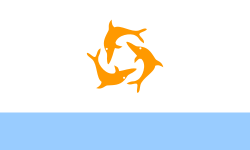 | |
| Use | Civil and state flag, state ensign |
|---|---|
| Proportion | 1:2 |
| Adopted | 30 May 1990 (modified coat of arms on 25 January 1999) |
| Design | A Blue Ensign charged in the fly with the coat of arms of Anguilla |
 | |
| Use | Civil ensign |
| Proportion | 1:2 |
The national flag of Anguilla, a British overseas territory, consists of a Blue Ensign with the British flag in the canton, charged with the coat of arms of Anguilla in the fly. [1] The coat of arms consists of three dolphins in a circular formation, which were featured on the earlier Anguilla flag, and which stand for friendship, wisdom and strength. [1] The white in the background stands for peace, and the light blue represents the sea, as well as faith, youth, and hope. [1]
Contents
The flag is Anguilla's third flag other than as part of Saint Christopher-Nevis-Anguilla. The island's first flag was a red flag featuring the name of the island in yellow and two mermaids inside a blue oval. [2] Variants to this flag were also widely used, with some substituting red for purple and some not bearing the name of Anguilla. [3] This flag was widely disliked and was replaced during Anguilla's brief period of independence by the Dolphin Flag, which is still widely seen around the island. This flag was a banner of the arms found on the current Blue Ensign, and was white with a broad blue band across the base of the flag, above which were three stylised golden dolphins.





